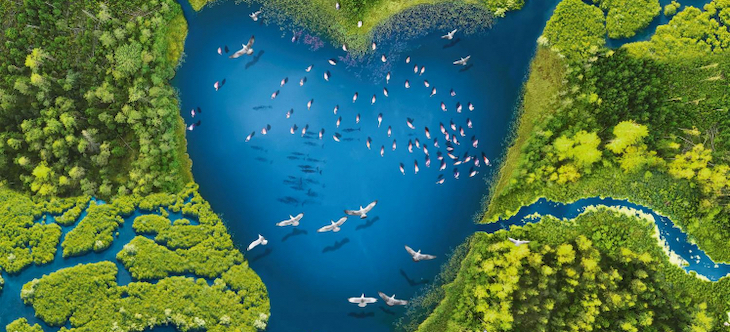Marshes, peat bogs, wet grasslands, lagoons, mangroves, estuaries, coral reefs, rice fields: they are all wetlands, since the term brings together a large number of ecosystems, from mountain peaks to coastal coasts. They are land covered with shallow water or impregnated with water permanently or temporarily, of natural or anthropogenic origin.
Los wetlands They are among the most complex, productive and dynamic, although also most fragile, ecosystems on the planet. They supply us with water and food, they help mitigate the effects of the climate change, contribute to controlling floods, mitigating droughts, protecting the coast and filtering water, among other services. In addition, they improve air quality, provide raw materials and genetic resources for medicines and hydroelectric energy.
The loss and degradation of wetlands is due, in large part, to changes in land and water use, as well as the climate change. Almost 90% of the planet’s existing wetlands have been lost since the 18th century. Although the pace of disappearance accelerated especially from the 20th century onwards, coinciding with the improvement of technological capabilities. In fact, it is estimated that between 1970 and 2015 wetlands shrank by approximately 35% (a rate three times the rate of forest loss).
Wetlands and human activities
Human activities contribute not only to the disappearance of wetlands, but also to its pollution. Untreated sewage, industrial discharges, agricultural runoff: since the 1990s, water pollution has worsened significantly.
In almost half of OECD countries, pesticide concentrations in water in agricultural areas are higher than nationally recommended thresholds. By 2050, a third of the world’s population is expected to be at high risk of water pollution from nitrogen and phosphorus.
These chemical elements, which cause the proliferation of algae, nitrogen oxides from fossil fuels, ammonia from agriculture that generates acid rain, pollution from power plants that causes oxygen depletion, are many other factors that cause the disappearance of biodiversity. As for the wetlands coastal areas are also contaminated by billions of plastic particles.
Multiple benefits of wetlands
Los wetlands They sustain the economy, providing more than a billion jobs and services. They also protect us from natural disasters and mitigate the global warming, since they are directly related to water. In addition, coastal wetlands serve as natural shields for local communities from storms.
And every hectare of the wetlands continental absorbs more than 13.5 million liters of water in floods. In addition, they act against climate change: mangroves, peat bogs, salt marshes and seagrass beds are some of the ecosystems more effective at absorbing and storing carbon.
Currently, 75 wetlands Spaniards have been included in this List of the Ramsar Convention and declared, therefore, of International Importance. Spain being the third country in the world in number included in the List Ramsar, only behind the United Kingdom and Mexico. Which demonstrates the strong commitment of our country to the conservation tasks of these ecosystems.
Its preservation is crucial
In the face of climate change, growing demand for water and increased risks of floods and droughts, wetlands They have an essential role to play in sustainable development. They also contribute, directly or indirectly, to the achievement of 75 of the 232 indicators of the Sustainable Development Goals (SDGs).
The Ramsar Convention is an international treaty that was adopted on February 2, 1971 for the conservation and sustainable use of wetlands and is structured around three pillars: the wise use of all wetlands, the designation and conservation of Ramsar sites and the promotion of transboundary management.
There are more than 2,300 Ramsar sites in the world, making it one of the largest networks of protected areas in the world. However, this represents less than 20% of the world’s wetlands, hence the need to continue expanding the network. Several studies highlight its multiple benefits, such as public awareness, growing support for the protection and promotion of ecotourism and research.

